#gm tools
Explore tagged Tumblr posts
Text
Get your inns, taverns, pubs, and alehouses here!
You all meet up in an inn. But what's the inn like? What's it called? What can you do there? And how do I satisfy my players' unending appetite for entertainingly-named inns?
This generator has your answer. It will give you a name, a brief description including reputation and proprietor, and optional entertainments and encounters. Or you can generate a name and do the rest yourself!
Here's some names:
The Shirking Eagle
The Flea's Head
The Void on the Bridge
The Wrestler and Newt
The Mouse House
The Sheep's Serpent
The Honourable Eel
The Spectacles and Sword
The Bald Orb
The Smiths
The Toad on the Dragon
The Fighting Magpie's Arms
63 notes
·
View notes
Text
d66 Ways to Explain This Player Character’s Brief Absence
Aw beans, one of your players couldn’t show up to tonight’s game. Here’s 36 ways to explain why their character is missing just for this session! Roll a d66 (rolling one d6 for the tens-digit and another d6 for the ones-digit) or choose an option that makes sense for your situation.
For brevity, “PC” will be used in place of the missing player character’s name.
11: PC had previously sworn an oath to a wizard they were indebted to, granting the wizard one-time power and authority to temporarily summon PC to them whenever they require their aid. The wizard is cashing in right now.
12: PC found a cursed scroll which temporarily turns them into an incorporeal spirit, forced to haunt the other player characters undetected until they learn some moral lesson the scroll wants them to learn.
13: A faerie spirit on a quest for revenge mistook PC for someone else and stole them away in the night. They’ll return PC once they realize their mistake.
14: The battle of two quarreling chronomancers blew through your location, and PC fell into a time-rift left in the wake of one of the wizard’s attacks, sending them into the (near) future.
15: Aliens abducted PC but will return them when they prove too difficult to contain/experiment on.
16: PC finds themself trapped in a time-loop, and eventually discovers that they only way to escape is to avoid contact with the other player characters for the duration of the loop.
21: PC overheard something the other player characters said about them out of context and misinterpreted it in a way that greatly upset them. They sneak away to abandon the group when no one is looking but return upon realizing it was all a misunderstanding.
22: PC has an important family (or other personal) matter to attend to that requires their swift response, as it involves legal recourse surrounding the disappearance of someone close to them. They will return once it is settled.
23: A scatter-brained wizard’s apprentice studying teleportation magic accidentally switches places with PC, teleporting them to their mentor’s tower an impossible distance away. The apprentice thinks they can figure out a way to swap back with PC if given some time on their own. They hope PC hides in their study until they do – their master tends to fireball intruders on-sight and ask questions later.
24: PC has been possessed by a ghost, who will return control of their body to them once they complete some task the ghost wasn’t able to finish before they died.
25: PC stepped away to refill their water, and got turned around on their way back. They wandered around lost a while, but will find their way to the other player characters eventually.
26: A faerie spirit decided they fancied PC and whisked them away to the faerie realm in an attempt to seduce them. They’ll return PC once they realize they aren’t their type.
31: An enterprising minor demon wants to strike a bargain with PC and teleports the two of them to the top of a tower in an attempt to show off. However, the demon’s pitch is not going well, especially when it’s revealed they lack the power to get them both back down again without resting a while first.
32: PC is called in for jury duty, and either has to serve their time or go to the local magistrate to appeal for a waiver.
33: PC ran into an old friend and went to catch up with them over some drinks. However, the two of them got held up by some of the friend’s newest adversaries.
34: PC is avoiding the other player characters while they prepare a surprise for one or all of them – a gift, or a party to commemorate a certain event like an anniversary or holiday.
35: PC is troubled by recent events – related to the group’s adventures, or external to them – and wants some time alone to clear their head.
36: PC has been haunted by dreams of a symbol in a dark room. They spot this symbol on a stray cat and can’t help but investigate. It seems to be leading them somewhere, but only if they follow it alone.
41: PC is visited by the restless spirit of a friend long gone. Their ghost wants to tell PC a secret – a secret that they must take to their own grave – and leads them away from the rest of the player characters.
42: PC has been struck by sudden inspiration for a work of art, and they simply must bring it into the world before the inspiration fades.
43: PC received an ominous warning from a fortune teller to stay away from [events of today’s session] and is keeping a safe distance just in case.
44: PC is having a crisis of faith in themselves after recent events and takes off on their own for a while until they reassure themselves of their skill. Training montage optional.
45: PC is sent a threatening message by one of their adversaries telling them that if they don’t leave the group, their allies will be made to suffer for it. They leave, believing it to be some heroic self-sacrifice. They return once they realize they are all stronger together, and only with each other’s help can they defeat the adversary’s threat.
46: PC tried to follow an “astral projecting for dummies” guide as a joke, but ended up separated from their body until they figured out how to stop.
51: PC ran afoul of a witch years ago, who tried to curse PC with eternal sleep. However, the witch got their arcane verb-tenses mixed up. So instead, PC was cursed to sleep through a specific date and time. That date is today.
52: PC is shown something that causes them to doubt if their cause is the right one, and leaves until they can find out the truth. They return when what they were shown is proven to be a fabrication by their adversary to mislead them.
53: PC leaves the group because they feel their contributions aren’t appreciated enough. They return after some self-reflection reveals they weren’t feeling unappreciated, they were feeling jealous.
54: PC is feeling extremely ill today. If your group has access to magical disease relief, specify that such relief will still take time to affect whatever sickness has befallen PC – it will just relieve some of the pain in the meantime. Until then, they require rest.
55: PC must take a day off for an important religious observance of their faith.
56: PC received a message from a character they flirted with in town, inviting PC to come visit them for some fun. They sure are taking their time coming back.
61: A minor celebrity from one of PC’s niche interests is going to be in town sort-of-but-not-really nearby, and PC just can’t miss this opportunity to meet them!
62: PC accidentally stumbled into the secret hidden lair of a C-list villain. It will take them a little bit of time to escape on their own.
63: PC saw a rare, elusive mystical beast, prized by many, such as a unicorn. They chased after this once-in-a-lifetime opportunity and will return very disappointed.
64: PC is in a sour mood after accidentally breaking a sentimental keepsake, and just wants to be alone for a while.
65: PC insulted a wizard, who responded by turning PC into a pile of rats. Rats, plural. We’ll have to collect all of them up before they can be changed back.
66: PC is just feeling soooooo eepy. Little nap.
163 notes
·
View notes
Text
Some astronomically unusual habitable worlds
Or, weird star systems that include a habitable planet, or at least one in the habitable band that could be terraformed, on the assumption that systems you can live in are more interesting than those that can't. "Habitability" is a bit of a stretch here; a habitable world could be anywhere from "it has an evolved biosphere with plants you can eat" to "an airless rockball, but if you pelt it with enough comets, put a biosphere in place, maybe you could eventually live there" or perhaps one where someone already did the hard part; that part is deliberately vague depending on how hard your sci-fi is.
Throw these on a d10 or 2d6 table or something; stick "planet orbiting a yellow dwarf" and "moon of a gas giant orbiting a yellow dwarf" in the most common spots, and you're good to go. This is a draft of a setting design generator table I might use. I might use it for Stars Without Number or I might use it to fill in stuff about under-developed systems in BattleTech, for instance. None of these have precursor aliens so that they can be used in settings that don't include them (if you add precursor space habitats to your star system tables, you can get pretty wild and I do fully encourage that), though one of them assumes humans have been at this space colonization thing for centuries. Likewise, this doesn't include anything that requires Weird Space Magic, like hollow worlds with an antigravitational inside and an inner pseudosun. If that exists in your setting and you're building a Weird Planets table then by all means put that in.
If you want to follow real astronomical commonality, small dim stars are much more common than big bright ones. I'm not an astrophysicist, though, and I haven't done the math to demonstrate that any of these are physically possible.
A world in a distant orbit around a bright star. Because luminosity increases with mass faster than gravity does, this world has a very long orbit; seasons might last decades. Depending on the role solar gravity plays in your setting's FTL (if any), these planets might be faster to reach coming out of FTL.
Converse to that, circumbinary planets (with two closely-orbiting stars at the center of the system) will have shorter years in the habitable band, since the mass is divided among two separate stars leading to much lower luminosity for the same mass
A world in a spread-out binary star system (the planet is closer to its primary than the other star is). The other star shines brightly on it. In the right time of year, there's never a night dimmer than a full moon.
A spread-out binary system with two separate habitable worlds, light-hours or light-days apart
A planet in a binary system with two stars of greatly different brightness, but because of relative distance they appear similar. It's tide-locked to the dimmer star, giving it an uninhabitable hot side and an inhabitable side with a day/night cycle.
A world in a highly eccentric orbit around an extremely bright star. In time, it will fall in to the inner system and its seas and atmosphere will boil away, but that's maybe a century or three out
That same world, coming out the other side. It might have scorched ruins on it, left behind when it was abandoned. It's on its way to the outer system, where it will freeze for a thousand years or more.
A planet that distantly orbits a black hole or neutron star, its atmosphere restored after the supernova burned it off. At the rate its primary is radiating (remnant heat/accretion disk), it's exactly in the habitable band, for now.
An outlying "moon" of a gas giant. Instead of orbiting its primary properly, it orbits at the L4 or L5 Lagrange point
A binary planet in a low orbit around a red dwarf. Their tidal forces on each other are the only thing that has kept them from becoming tide-locked to their primary.
58 notes
·
View notes
Text
After running Dead Beats a couple of times and dealing with the ever-changing numbers during combat, I wanted to make an Excel sheet with a bit of autofill and reminders for my own benefit.
Now I'm looking at it, and trying to get the stuff to work and I question whether I am better off trying to relearn Python and make a little widget for that instead.
How hard could it be?
#python#programming#excel#tabletop roleplaying#tabletop rpgs#ttrpg#gm assistance#gm tools#dead beats rpg#dead beats
5 notes
·
View notes
Text
I am in all things,
Each shade and hue.
Invisible,
Yet visible too.
You only see the surface
When I see you.
A riddle. Probably thought I'd put the answer down here, didn't you. But not yet. If you have a guess stick it in the tags.
24 notes
·
View notes
Text
Friend linked this in a Discord server and it looks neat and useful. It's a free PDF detailing a short and simple method of procedurally generating a dungeon's overall structure. Enjoy!
2 notes
·
View notes
Text
With how common the fantasy setting is in TTRPGs and how common the medieval setting is in fantasy, this is an incredibly intriguing read.
For once, I'm even going to recommend diving into the comments because there's some added information and good debates. It's definitely worth looking these things up ourselves, too.
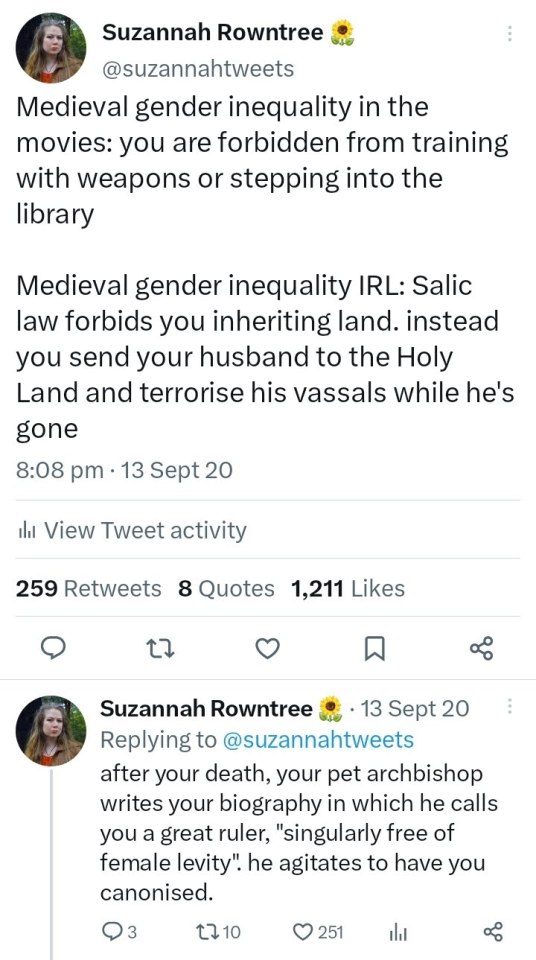
all RIGHT:
Why You're Writing Medieval (and Medieval-Coded) Women Wrong: A RANT
(Or, For the Love of God, People, Stop Pretending Victorian Style Gender Roles Applied to All of History)
This is a problem I see alllll over the place - I'll be reading a medieval-coded book and the women will be told they aren't allowed to fight or learn or work, that they are only supposed to get married, keep house and have babies, &c &c.
If I point this out ppl will be like "yes but there was misogyny back then! women were treated terribly!" and OK. Stop right there.
By & large, what we as a culture think of as misogyny & patriarchy is the expression prevalent in Victorian times - not medieval. (And NO, this is not me blaming Victorians for their theme park version of "medieval history". This is me blaming 21st century people for being ignorant & refusing to do their homework).
Yes, there was misogyny in medieval times, but 1) in many ways it was actually markedly less severe than Victorian misogyny, tyvm - and 2) it was of a quite different type. (Disclaimer: I am speaking specifically of Frankish, Western European medieval women rather than those in other parts of the world. This applies to a lesser extent in Byzantium and I am still learning about women in the medieval Islamic world.)
So, here are the 2 vital things to remember about women when writing medieval or medieval-coded societies
FIRST. Where in Victorian times the primary axes of prejudice were gender and race - so that a male labourer had more rights than a female of the higher classes, and a middle class white man would be treated with more respect than an African or Indian dignitary - In medieval times, the primary axis of prejudice was, overwhelmingly, class. Thus, Frankish crusader knights arguably felt more solidarity with their Muslim opponents of knightly status, than they did their own peasants. Faith and age were also medieval axes of prejudice - children and young people were exploited ruthlessly, sent into war or marriage at 15 (boys) or 12 (girls). Gender was less important.
What this meant was that a medieval woman could expect - indeed demand - to be treated more or less the same way the men of her class were. Where no ancient legal obstacle existed, such as Salic law, a king's daughter could and did expect to rule, even after marriage.
Women of the knightly class could & did arm & fight - something that required a MASSIVE outlay of money, which was obviously at their discretion & disposal. See: Sichelgaita, Isabel de Conches, the unnamed women fighting in armour as knights during the Third Crusade, as recorded by Muslim chroniclers.
Tolkien's Eowyn is a great example of this medieval attitude to class trumping race: complaining that she's being told not to fight, she stresses her class: "I am of the house of Eorl & not a serving woman". She claims her rights, not as a woman, but as a member of the warrior class and the ruling family. Similarly in Renaissance Venice a doge protested the practice which saw 80% of noble women locked into convents for life: if these had been men they would have been "born to command & govern the world". Their class ought to have exempted them from discrimination on the basis of sex.
So, tip #1 for writing medieval women: remember that their class always outweighed their gender. They might be subordinate to the men within their own class, but not to those below.
SECOND. Whereas Victorians saw women's highest calling as marriage & children - the "angel in the house" ennobling & improving their men on a spiritual but rarely practical level - Medievals by contrast prized virginity/celibacy above marriage, seeing it as a way for women to transcend their sex. Often as nuns, saints, mystics; sometimes as warriors, queens, & ladies; always as businesswomen & merchants, women could & did forge their own paths in life
When Elizabeth I claimed to have "the heart & stomach of a king" & adopted the persona of the virgin queen, this was the norm she appealed to. Women could do things; they just had to prove they were Not Like Other Girls. By Elizabeth's time things were already changing: it was the Reformation that switched the ideal to marriage, & the Enlightenment that divorced femininity from reason, aggression & public life.
For more on this topic, read Katherine Hager's article "Endowed With Manly Courage: Medieval Perceptions of Women in Combat" on women who transcended gender to occupy a liminal space as warrior/virgin/saint.
So, tip #2: remember that for medieval women, wife and mother wasn't the ideal, virgin saint was the ideal. By proving yourself "not like other girls" you could gain significant autonomy & freedom.
Finally a bonus tip: if writing about medieval women, be sure to read writing on women's issues from the time so as to understand the terms in which these women spoke about & defended their ambitions. Start with Christine de Pisan.
I learned all this doing the reading for WATCHERS OF OUTREMER, my series of historical fantasy novels set in the medieval crusader states, which were dominated by strong medieval women! Book 5, THE HOUSE OF MOURNING (forthcoming 2023) will focus, to a greater extent than any other novel I've ever yet read or written, on the experience of women during the crusades - as warriors, captives, and political leaders. I can't wait to share it with you all!
#gm tools#world building#fantasy#ttrpg stuff#ttrpg design#ttrpg community#ttrpg family#ttrpg oc#ttrpg character
31K notes
·
View notes
Text

SUPERVILLAIN PLOT GENERATOR
With this latest release I finish my trilogy of superhero rpg tools. The Supervillain Plot Generator is a table of eighty items each for five categories. It’s useful for all kinds of superhero games: Mutants & Masterminds, Marvel, Wild Talents, Masks: A New Generation, etc.. You can combine this with the Supers City Events and Superhero B-Plot releases. Rather than dump the text of this into the blog post, here’s a link to a pdf of the table.
On itch.io you can pick up a Print & Play version of the Plot Generator as cards. It’s also up on Drivethru and once I get a proof copy, I’ll have a physical deck you can purchase via Drivethrucards. I’ve got those for most of the decks so far and there’s a real, tactile pleasure to having them. As before: the text of this is released under CC 4.0 Share Alike Attribution. It is not AI generated nor to be used with any kind of generative AI.
What does the plot generator have?
Plot: What operation is the villain carrying out? (Switch Bodies, Raid Alternate Worlds, Capture Hero). This is the “crime” the villain (or villain group) is carrying out. It might be a starting point, an ongoing plan, or something they’re building towards. I’ve tried to offer a mix of these, but also leave them open enough that the GM can take them in different directions.
Goal: Why is the villain doing this? (Dissolve Trust in Something, Gain New Powers, Attack and Dethrone God). This is optional, but combining this with the plot can create interesting new directions. It potentially gives you a new take on the villain’s motivation and sets up future events if the PCs thwart this operation. I like the context this gives and the 6,400 possible combinations means you can generate some wild stories.
Low-Stakes Location: Incidental places for investigation, encounters, or preliminary skirmishes. (Gymnasium, Waterway Runoff, Megacorp Distribution Center). I wanted a quick list of distinct places I can have pop up during the game– not for the climax, but during the figuring-out phase. I’m working to not always fall back my go-to’s like diner, warehouse, and nightclub locations.
High-Stakes Location: Key sites for operational targets, hidden bases, and final battles. (Private Military Contractor, Bio-Weapon Lab, High-Speed Train). Here I wanted places which would be interesting for staging a fight. They can be high-stakes for many reasons: security, inherent danger, threats to bystanders, expensive items. Many are unique and distinctive, helping complete the story created by the combination of plot and goal.
Complications: Twists, turns, and swerves which may impact the heroes and/or villain. (Turncoat Hero Involved, Family Ties Revealed, Need the Help of a Foe). This is another one that can recolor and recontextualize the villainous operation. I’ve written many of these so they can be seen either from the PoV of the PCs or their enemy. Like Need the Help of a Foe reads very different if the villain’s looking for aid versus the PCs trying to take the mastermind down.
MY SUPERS PREP
I have a big collection of supervillain sourcebooks. They come from Champions, Silver Age Sentinels, ICONS, various M&M editions, and beyond. And while I appreciate all the backstory and background provided with each of these I often ignore or skim these for highlights at the most. I want a cool concepts, set of powers, and image. I then slot these into my plots. It’s best if they’re from the system I’m running so I don’t have to build a new template.
I don’t know if that’s how other GMs do it. But I got used to reading through villain books and finding the character stories steeped in the concepts of a particular setting. I’d have to tweak elements and/or integrate those bits into my game. Sometimes that brought new, cool things, but sometimes it over complicated it when I tried to port-in wholesale new big plots, metastories, and organizations. So I started skipping that.
My goal with this is: find a cool villain or set of villains, generate the elements above, and figure out their backstory from there.

THOUGHTS ON GM TOOLS
The idea of having goals & complications is inspired by several different Blades in the Dark heist decks and The Game Master’s Handbook for Proactive Roleplaying. I can imagine maybe doing a Fantasy version of this, but I think a Cyberpunk or Modern Urban Fantasy might be more difficult– the specifics of those settings could get in the way.
Why cards? I love the tactility if we’re face to face: at home or at a con. I take picture cards, cards with entanglements, cards with names. The Faction Builder and City Builder toolkits offer a distinct use case from the other tools. They can generate ideas on the fly, but they’re more often session zero collaborative resources. I love being able to deal out cards or put them in the middle of the table for folks to work through. They can always come up with something else, but don’t underestimate the power of gently modeling something for your group.
So why do all these other tools and why do them as cards? For this I have to talk about my GMing hang ups– more style than philosophy. I like random tables. I especially appreciate those created by Kevin Crawford for his stuff. But I also dig all the various tables and tools used in lots of different OSR games. I pulled a couple of Diogo Noguiera’s small, stand-alone games off the shelf to look at. I love the weirdness of A Thousand Thousand Islands, and Augmented Reality is my go-to for any urban, cyberpunk, or sci-fi game.
But I find myself mostly using those in one of two ways. On the one hand I explore them to build some bits pre-session. So I create an eldritch conspiracy in Silent Legions or generate a court with Godbound’s tools. They give a skeleton framework– and I’d say about a third to half of the time I end up using them. On the other hand, I also read through these tables to prime the pump. They inspire my descriptions and details. In particular I skim through Augmented Reality before a session and note down sensory details and setting elements.
But I don’t like to use tables when I’m actually at the table. I appreciate GMs who can do that smoothly and quickly. Two great OSR GMs I’ve played with, Anya and Horst Wurst, do that with a natural skill– making it a point to draw players into the random nature of it. There’s an invitation to appreciate how the dice change the direction of things. There’s also an element of Apocalypse World’s disclaiming responsibility there.
But I don’t like switching and flipping through tables myself. My mental process when I’m running has a tight set of sockets. My attention’s on the players, the character keeper (if online), a rules ref page (if necessary), my notes (mostly what I’m writing down but sometimes small lists I’ve created beforehand), and the time. More trad games like 13th Age and Mutants & Masterminds add foe record sheets. It always takes me a while to integrate those into my process. That’s about my limit.
Which means I don’t like pulling out a book or extra print-out pages. Even pulling up a pdf feels wonky to me. And I stress: to me. I bet most GMs actually have a handle on managing this. I love collections of rumor tables and happenings, but I don’t want to stop, grab a book, and have to do a look up. My space is chaotic enough as it is.
But cards, oh cards. I love them. They take up less space. I can stack them in boxes. I can quickly draw and glance at them for ideas and inspiration. I can easily hide that I’m doing that if I’m feeling particularly anxious. But I can also fuck around with them to deal with my general nervousness and constant low-level panic when I’m running.
They’re TTRPG fidget spinners, with added utility.
So that’s why I’ve made all of these tools– they’re a thing I wanted and I hope they’re useful to other GMs.
Again, you can check all of these out on Itch or Drivethru.
1 note
·
View note
Text
Just did up a quick worksheet, mostly for myself, figured I'd post it up.
The idea is to cross over a few things:
get the small local vibe from hex flower
get the exploration aspect from a proper hex crawl
get the efficient use of detail from a point crawl
heavily encourage the use of landmarks
Anyway might fill out a couple myself if I have time!
1 note
·
View note
Text



To-do list Printable
Need help keeping track of what you need to prep for you campaign? Or just tracking tasks in general?
Focus on your next prep GM tasks with this printable to-do list. You can print how many you need, in you preferred paper, and use them as-is, or punch discbound holes and insert them in your notebook.
It has a very minimal design so it doesn't distract you and fulfills its purpose.
It comes in 4 colors, in A7 sizing and with margin for discbound punch-hole, so you can take it everywhere with you.
Purchase this printable here.


#printables#productivity#to-do list#gm tools#ttrpg#would you be interested in the stand?#that is still a prototype and i cant export to out of europe yet#for now it's just a thing for me to use
1 note
·
View note
Text
I avoided mentioning this in my religion in fantasy post because it automatically turns people off but yes a vast majority of religions in fantasy are christianity lite because of cultural christianity.
the thing folks living in Christian dominant cultures gotta realize is that even if you’re not Christian, your basic understanding of religion and spirituality and morality is still being filtered through a Christian lens. your very concept of what religion is and does is filtered through that lens.
130K notes
·
View notes
Text
csp mini guide: edge eraser!
@lunasun hihi!! i tried to make an visual and wrote an explanation i hope this makes sense but if not then i failed LOL i hope you don't mind the tag





Erase Along Edge (Edge Eraser) text version!
1. Sketch or line as normal on one layer. 2. On a separate layer, below the lineart, color as normal. 3. Return to the lineart layer, and set it as the "Reference Layer". (Toggle ON by clicking on the lighthouse icon!) 4. Return to the color layer, select the "Erase Along Edge" tool, and erase the offending overlap! Aaand then you're done! Try stick to the outside of your lineart to avoid accidently erasing what's inside. As long as your brush size is reasonable, it shouldn't erase what's inside too much or at all unless if your cursor is inside of the lineart!
Quick Troubleshoot
"It won't erase properly?" "My lines aren't opaque and/or is too messy." That's OK!! While I do recommend solid lines (few gaps or none) or opaque lines (at 100% opacity), it's NOT necessary! It just makes using the tool easier! Most of the time you can get away with it, so don't worry about having to change your style or anything. If the lines are not solid (have gaps) or aren't opaque (lower than 100% opacity), please refer to the tool properties/settings! You may need to experiment here. Adjust the "Tolerance" and "Area Scaling" settings and repeat the process until you reach your desired result! Please note: If lines intercept (creating small "pockets) or opacity is still an issue you may have to manually erase anyways (sorry lol). By all means, it isn't perfect BUT it is a BIIIGG time saver once you have it down! The creator (pharan) makes more specific points and fixes in their guide that is far more in depth! I just want this to be easy to understand for anyone who's never used it before or is trying it for the first time! :)
#clip studio paint#csp ex#csp pro#fnaf daycare attendant#dca fandom#moondrop#pingdoobles#god i HOPE this makes sense#please tell me if it doesn't!!!#im not used to making guides or anything and i DO NOT claim to be a professional#im also happy to answer more questions or help further explain if there's still confusion!#ok i need to sleep i have to work and it's almost 6am awkughaw#will make a 2nd guide on the lasso fill tool “ice cream man” thing sometime l8r#idk when later is but at some point#my eyes are drooping while i type god#i am the eeper gn!! (or gm??)
166 notes
·
View notes
Video
youtube
The Lancer Map Creation Tool by Interpoint Station is a program that lets you create complex yet readable battlefields in minutes, featuring a random generator to generate a map in seconds as well as assets integration to create your own terrain asset and biome.
174 notes
·
View notes
Text
hoho! art thou making battle maps? fantasy world cartography, perchance?
forgotten adventures has +120 000 high resolution assets [11 GB] available to download for free on their website!
frequent user of dungeon draft? they have +30 000 free objects available on their starter pack as well!

#websites#dnd#dm tools#tech tips#wizardblr#dnd maps#dnd resources#ttrpg#ttrpg community#pathfinder#worldbuilding#gm advice
161 notes
·
View notes
Text
Hey all, This is my first Tumblr post ever! I'm pretty new here, but I'm hoping to share some DM techniques, tools and tips and to make some new friends as well! Feel free to send a chat request (an ask[?]) if you're interested!
With that aside, on with the post!
Better and More Meaningful Random Encounters!
Random encounters are a staple of DnD, they are expected to be there during exploration as a way to make the world feel alive, to have it have an aura of adventure and danger, to eat up party resources and put pressure on the PCs to make interesting and important choices, and also as a way for a DM to reasonably 'stall' the party with a quick and easy situation.
Usually, it ends up something like this:
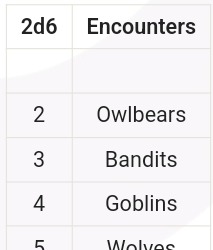
There's just one problem with most random encounter tables though, it's so easy for them to be GOSHDARN BORING! Especially for a newer DM.
Making them interesting becomes gambled improv on the DM's part if they're not used to it, and it's hard to keep track of the important factors that need to be kept in mind
Luckily, I ended up finding a great source for random encounters from 'Dungeon Masterpiece' on YouTube, and I integrated it into my own DMing. I figured that I'd share it here for any that want to work it into their own sessions as well!
After adjustment, a single table can account for multiple entire sessions of in-depth worldbuilding and fun without getting dull!
Sources:
Source 1 (Creating interesting Random Encounter Tables):
youtube
Source 2 (Making Random Encounters reflect your Worldbuilding):
youtube
There's 4 major methods we can use to improve the Random Encounter table
1. Make the table a straight 1dx roll.
2. Adding 'depth'.
3. Adding meaningful encounters.
4. Prerolling and/or Multirolling.
You can also check out the "Where to Start?" section for some direction to make getting it down and prepped all easy peasy!
1. Straight Roll:
Its enticing to go for 2d6 or the such in order to add non-linearity to the rolls, but these sorts of adjustments only end up making one or two encounters extremely likely and leave all others in the dust, it often ends up defeating it's own purpose of interesting randomness.
In the previous example, it was extremely likely to only get Wolves, Barbarians, Orcs, or Spiders, from a table of 12! A straight roll would serve us much better. The rare rolls are already rare enough as is!
Simply enough, adjusting the original example by replacing the 2d6 with 1d12, it'd become something more like this:
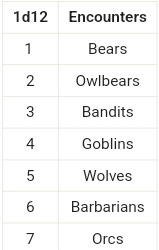
#2. Adding Depth:
We can add more columns in the encounter tables. These columns will represent different aspects about the encounters that we can roll on separately!
Usually it can be difficult as a DM to naturally come up with motives for the encounters, showcase the worldbuilding and have it all come together.
This setup can give you a solid guideline on how the creatures/people think (if any), and also sets up the overall area so that you get an idea of what events tend to occur there as a result of its occupants.
We want to add 3 more columns to the tables to convey different aspects of the encounter. Fill in these new columns corresponding to the expectations of each encounter.
We'll roll each of these and combine them, then we'll interpret them to make a robust, in-depth random encounter with truly unexpected results!
I recommend rolling alot of complete encounters at once and interpreting the context to the vast general area the party is travelling in.
i. Behaviour: How the creatures act. Are they friendly, scared, aggressive, curious, mischievous?
ii. Complication: Something behind the scenes in the encounter. Do they have sick young? Broken equipment? Are they starving?
iii. Significant Impact: This is a tick box, and will only be present under ONE of the rows. It will be rolled like the other columns, but ONLY once. It signifies which encounter is the Significant Encounter
The Significant Encounter will have its encounter's presence prominent amongst all the other random encounters in the area. There could be burn marks and carcasses from a rampant dragon, or a goblin raid leaving tracks moving through the area. Which is the most impactful of the different encounters?
Adding this to our previous example would expand it to:
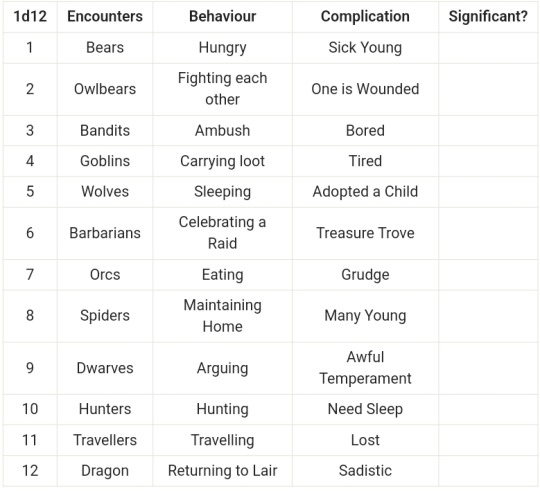
Rolling this would give us things like:
Significant encounter: Owlbears

Note that the significant impact shows that the Owlbears are a massive problem in the area. Perhaps the Owlbears are agitated for an unknown reason, and are unnecessarily aggressive.
The significance of Owlbears gives us context to the second one as well! Perhaps the hunters raided an Owlbear den, and adopted an Owlbear cub from there as well.
There could be uneaten carcasses, ravaged trees, less wildlife, etc around these parts.
Note how much sheer CONTEXT these columns add to our encounters. It's invaluable!
3. Adding Meaningful Encounters
Usually random encounters tend to be rather mundane and very one-note.
There's usually some general wildlife and monsters, different disparate factions without any rhyme or reason, and maybe a general non-combat encounter or two, but these don't really tell us about the area or its surroundings at all by themselves.
Instead, we can add in wildlife and monster encounters specific to the biome, non-combat encounters, and encounters of nearby factions and/or settlements to the table, and we can even add environmental encounters in there as well.
Note that we're not tied down to 12 encounters, and can expand it ad infinitum according to our need of diversity in our encounters.
Just add in specification and connection, and suddenly the dominos all fall into place.
Lastly, we'll also be adding in 'DOUBLE TIME' which will let us roll on everything twice, and make it so it's a double encounter!
Thus, the table can instead be adjusted to:
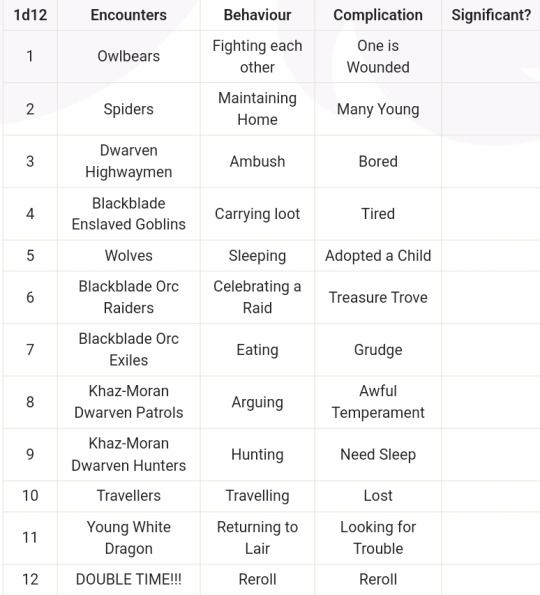
Note how each and everything has its relation in one way or another, but through the sheer variance, they remain truly random and novel.
4. Prerolling and/or Multirolling
Lastly and this is just something that I do, but that I found gamechanging. Be sure to pre-roll 5-7 encounters for each session, for the general area the players are going to be headed in.
Note that you don't need to really prep anything at all, just interpret all of them on a surface level as a buffer.
Also note that you don't need to use all of them if they're not needed. The foreshadowing and signs are worldbuilding and having secrets that the players don't unravel is just as useful as the ones that they do, perhaps even moreso. It adds depth and detail beyond the scope of what the party will encounter
It simply let's you get an idea of the connections between encounters, allows for foreshadowing, and acts as a deterrent to getting caught off guard.
Even if you roll mid-session, I recommend calling for a 5 minute break, rolling 5-7 encounters at the same time and interpreting them and their connections before resuming the session.
It WILL make a difference, trust me
Where to start?
It can be difficult getting inspiration or direction to get started in creating these random encounters, and sometimes you don't want to go through the hassle of thinking them up from nothing
For some great conceptual headstarts and examples for these tables, you can check out 'Worlds Without Number' and it's:
- Page 205 (Great general templates for encounters differentiated by broad creature types such as Beasts and Monsters, Sapient Monsters, and Humans)
- Pages 206-219 (For inspired locations to occasionally run rare encounters or groups of encounters in. This works best with flexible/discovered worldbuilding given the significance of some of these, and you also want to add these in sparingly to keep them significant)
- Pages 246-247 (These pages have great templates for the kinds of encounters and situation to be included in the tables, and it can be expanded vastly, and certain options can be selectively and repeatedly chosen to meet our needs. Mood works well as a complication.)
There might be other pages that are useful as well for these sorts of random encounters in the wilderness that I haven't come across yet. If so, give them a shout out and I'll be sure to add them in. It's worth checking it out in its entirety for some great tips!
Conclusion
Again, credit goes to Dungeon Masterpiece and Worlds Without Number for excellent adjustments. This has been quite long, but I hope you stuck around till the end.
Many a session have been made easy but complex ever since this was introduced and I hope that this helps you out as much as it helped me in my prep and improv!
Feel free to give any advice in formatting on Tumblr, or any feedback on the post itself. It really means a lot to me, thanks!
#dm tools#dungeons and dragons tips#dungeon master tips#dm advice#dm tips#ttrpg#dnd#Youtube#dnd resources#gm tips
99 notes
·
View notes
Text
Project Updates - Aug 6, 2024
Back at it again! I'm hoping to get these devlogs up to at least once a month, if possible, assuming I can keep up this kind of pace with coding. Updates under the cut~
SWN GM Tool
When I decided to update my project list, I said I was moving my old SWN GM Tool down to a sort of backburner status. It felt a bit like the end of an era; the GM tool was my first real personal project that I had started after college and had been poking at it for the last ten years or so, so officially putting it on hold with a desire to come back to it one day was a little interesting.
Especially since I started working on it again that very same week.
I decided to start the whole project over, essentially, and use this as an opportunity to learn to use Godot more at the same time. Within a few days, I had made a simple Faction creation widget as well as a list of factions. In a week, I had a mechanism for saving that faction list to a file and loading it back up as well. All in a simple application made with Godot UI nodes!
I haven't touched the project again in a little over a month, now, but I'm feeling very good about returning and working more on it. Next steps are to make a Faction View scene that shows the stats and assets of the faction, and allows adding and removing assets. Once I feel like I have a good enough user experience for it - something that's not really my specialty - I'll probably upload it to itch.io with just the Faction and asset tracking. After that, I'd like to include a simple map and then a way to run the Faction Turn.
Libtcod Tutorials
Over a year after I received feedback from r/roguelikedev about my attempt at making a C++ tutorial for libtcod, I have begun making a concerted effort to continue working on the codebase again!
After the whole effort of getting a simple eventing system using double-dispatch in place, I took a pretty good break before returning. I decided to make sure the code was working on both Linux and Windows, and updated to the C++23 standard at the same time, which introduced some issues. At first I thought it was a problem with MSVC, but was able to replicate it with Clang as well. It turns out that the way I was doing virtual inheritance for the event handlers worked perfectly fine in C++20, but broke in C++23. Getting that figured out took a few days, but after that I confirmed it worked on GCC, Clang, and MSVC :D
Next I'm going to continue working on the actual tutorial code before I return to writing the tutorials for C++ again, to make sure that there's not more optimizations or architectural changes I'll want to do down the line that would be better to backport again.
3 notes
·
View notes